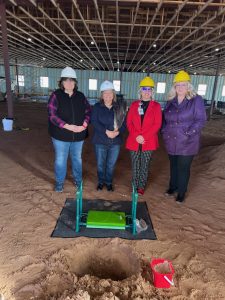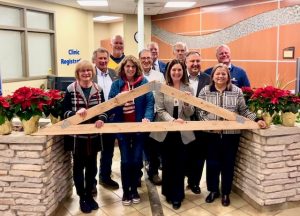Post From Community Close Ups
Mackinac County is a rural community of just under 11,000 residents in Michigan’s upper peninsula. A well-known tourist destination, it is the home to Michigan’s only state park that is completely pedestrian and car free. Despite a vibrant tourism industry, Mackinac County faced a common threat affecting many rural communities, hospital closure. In 2008, Mackinac Straits Health System (MSHS) forged several strategic community partnerships to save the area’s hospital. One of those partners included the county’s largest year-round employer, The Sault Ste. Marie Tribe of Chippewa Indians. By forming a collaboration rooted in trust and guided by a shared need, MSHS and the Sault Ste. Marie Tribe of Chippewa Indians turned the tide. Instead of closing the doors of another rural hospital, the partners opened a state-of-the-art healthcare facility and tribal health clinic.

Mackinac Straits Hospital staff and leaders
Mackinac Straits Hospital originally opened its doors in 1954, primarily as a long term care facility with very limited physician resources. Over time, the hospital, owned and operated by the county, struggled to remain open. The emergency room sometimes faced ectopic closures and operated on a cash reserve of only three to five days. They realized the hospital’s survival would require major interventions, including addressing the building itself which was dated and landlocked thus preventing the health system from expanding its current footprint. Karen Cheeseman, Chief Executive Director of Mackinac Straits, shared that the situation required “a complete revamp of [its] strategic plan, and that included a new building to grow the health system.”

Ceremony of placing an eagle feather in the entrance way to welcome healing for all who enter
The Sault Ste. Marie Tribe of Chippewa Indians is a sovereign, federally recognized American Indian Tribe with around 50,000 members. The Tribe’s service area spans seven counties across the upper peninsula of Michigan, including Mackinac County. In 1986, the Tribe became a 638 contracted tribe, later achieving self-governance status from the Self-Government Act of 2000.1 As a result of this status, the Tribe administers their own programs and services rather than federal government agencies like the Indian Health Service. This includes ten clinics and service units, providing critical healthcare to their citizens. Prior to 2008, the Tribe did not have a large clinic in each unit or county, including Mackinac, resulting in Tribal members having to travel long distances to reach one of the Tribe’s major health centers. To circumvent this service gap, the Tribe partnered with MSHS to create the Moses Dialysis Unit and the Tribe also provided essential medical services at the smaller satellite clinics. With both entities struggling to sustain up-to-date facilities and battling space constraints, the two came together to construct one building that would house both a new hospital and a tribal health clinic.
Partners: Mackinac Straits Health System, Sault Ste. Marie Tribe of Chippewa Indians, local, state, and federal representatives
Financing: Loans from United States Department of Agriculture, donations from Mackinac Straits Health Foundation, seed funds and land from Sault Ste. Marie Tribe of Chippewa Indians
Project status: Opened in 2010
Project scale: 82,000 square feet, two-story building. St. Ignace Tribal Health Clinic & Human Services Center encompasses 15,000 of 82,000 square feet

MSHS and St. Ignace Tribal Health Clinic & Human Services Center are located in the same building but are separate facilities that offer complimentary services. The St. Ignace Tribal Health Clinic is owned and operated by the Sault Ste. Marie Tribe of Chippewa Indians serving Tribal members. It incorporates both western approaches to medicine and employs traditional providers who specialize in traditional healing practices. MSHS is a non-profit hospital that serves Mackinac County and the larger Straits of Mackinac region, which includes Tribal citizens. Both partners are highly focused on the collaboration of care between the two facilities. MSHS, for example, provides laboratory services for Tribal citizens, shares an optical space, and provides after-hours care for Tribal patients at the hospital’s ER/Fast Care. By sharing resources, the partners can avoid duplication which can result in lost efficiency.
Prior to 1974, the Sault Ste. Marie Tribe of Chippewa Indians had no revenue sources of their own and struggled to cover member needs because federal funds were insufficient. That year, the Tribe became federally recognized, providing a legal framework that allowed for the adoption of a tribal constitution and the ability to elect a local government who could place their tribal lands into a trust. The Tribe subsequently built a business-based economy that provides “employment and revenues to its people while making a positive impact on the surrounding communities’ economic welfare, [including] land holdings, businesses, housing and other service centers.” Christine McPherson, Executive Director of The Sault Ste. Marie Tribe of Chippewa Indians, explains that the Tribe is well versed in economic development, “we (the Tribe) are looking for opportunities to build businesses that will bring back this revenue to our Tribe, which helps us with providing the services that our citizens need.”
The Tribe’s business acumen, experience in providing health services, as well as the major assets of land and seed funding were critical to the success of the joint project. Both parties knew that real estate and construction costs could be prohibitive. Therefore, the Tribe donated a 16-acre parcel of land valued at $1.2 million and $1 million in seed funding, which enabled the project to move forward. In exchange, the Tribe received around 15,000 sq ft of the hospital that was used to house the St. Ignace Tribal Health Clinic.

Trustees gather for a ceremonial signing in preparation for the installation of the last truss
Under the leadership and vision of MSHS’ former CEO, Rodney Nelson, the hospital worked with local, state, and federal partners to secure funding for construction of the building. A local congressional delegation made up of representatives such as former congressman Bart Stupak and Senator Debbie Stabenow, helped secure the U.S. Department of Agriculture’s (USDA) rural development community program starter loan of $12.2 million and a USDA guaranteed loan of $25 million. Cheeseman shared, “smaller, rural hospitals typically do not have lobbyists, government affairs departments, or other resources to help navigate complex government funding sources”, so the support network of partners became central to fundraising. The money proved beneficial for the Tribe, too. The Indian Health System often does not have start-up funds available or it can take years before any new construction is approved, McPherson shared.
To help facilitate this new funding, Nelson and the leadership of MSHS had the foresight to convert the hospital from an Act 47 hospital, operated by the county, to a 501C3, non-profit hospital. This set-up enhanced the hospital’s fundraising ability by creating the proper structure to pursue USDA small and rural development grants. The leadership also created the Mackinac Straits Health Foundation, further providing a bridge to the community. The foundation became a venue to bring in residents, recruiting support as they gained deeper knowledge of the project. By cultivating trust and increasing public awareness, the foundation raised an additional $6 million in donations for the new hospital. Cheeseman added, “it’s important to have the community behind us and demonstrate this to USDA.” MSHS successfully secured two more USDA loans to build the Evergreen Living Center, a long term care center, and a connector between the nursing home facility and the hospital. In 2013, MSHS borrowed an additional $3 million from the USDA to construct a surgery center.
Several factors contributed to the success and initial establishment of trust in this partnership as well as nurturing it as the work evolved.

Trustees and special guests gather for a groundbreaking ceremony for a new Medical Office Building that will open in August 2024
Today, the hospital continues to expand its services. Most recently in 2022, it received funding from the state of Michigan to construct a medical office building and surgical services with a focus on spinal robotics. Now, both partners are focusing on broadband opening up the potential for telehealth services. MSHS has several initiatives underway to expand broadband technology to their rural service areas, including participation in the EUPConnect Collaborative, a community coalition focused on developing broadband infrastructure in the Eastern Upper Peninsula of Michigan. Likewise, the Sault Ste. Marie Tribe of Chippewa Indians recently received both a $25 million grant and a $3.7 million grant from USDA’s ReConnect program to help provide high-speed internet access to the surrounding area. Both partners continue to collaborate with the Mackinac community to provide quality healthcare to their residents and citizens.
1. The goal of self-governance, as it applies to Indian Health Services programs, is to permit an orderly transition from Federal domination of programs and services to provide Indian Tribes with meaningful authority, control, funding, and discretion to plan, conduct, redesign, and administer programs, services, functions, and activities that meet the needs of the individual Tribal communities.